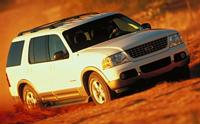New Car/Review
Ford Explorer (2002)
SEE ALSO: Ford Buyer's Guide
by John Heilig
SPECIFICATIONS MODEL: 2002 Ford Explorer XLT 4x4 ENGINE: 4.0-liter V6 HORSEPOWER/TORQUE: 210 hp @ 5,250 rpm/250 lb-ft @ 4,000 rpm TRANSMISSION: Five-speed automatic WHEELBASE: 113.7 in. LENGTH x WIDTH x HEIGHT: 189.5 x 72.1 x 71.9 in. STICKER PRICE: $34,505
The first impression I got when I saw the new 2002 Ford Explorer was that it was much larger than its predecessor. It seemed much longer and sleeker. But, as usual, I was mistaken.
While the 2002 Explorer is built on a wheelbase that is 2.1 inches longer, the vehicle length is actually shorter by1.2 inches. This means the wheels are pushed further out to the corners, resulting in more interior space and a better ride (Chrysler tells us that's the case with its sedans; why shouldn't it also be true for Ford trucks?). The increase in interior space is evident, and Ford makes good use of it by adding a third row bench seat. This isn't a seat that basketball players will feel comfortable in (unless they're high school point guards), but it is adequate for children or small adults.
Still, the Explorer has increased cargo carrying capacity. With the rear seat up, the volume is 45.4 cubic feet, versus 41.4 cubic feet in last year's model. With the rear seats down, capacity increases to 88 cubic feet, a full 8.2 cubic feet more than last year. If that doesn't seem like a lot, it's the entire luggage capacity of the Audi TT coupe.
But the new Explorer is more than just extra space, although that's a big part of the story. A new independent rear suspension is what created the optional third-row seat. That suspension also provides a more car-like ride (unusual in a truck-based SUV) and better handling. While we didn't have a chance to test the Explorer in mud or snow, we did use it in a lot of urban driving that is often a tougher test than off-road. The Explorer negotiated city streets and right-angle corners just as easily as it did back-country two-lane roads.
We took the Explorer to our remote office, which entails some Turnpike driving up and two-lane back. It's a good test of ride characteristics. There was some tire noise on the Interstate, but it was less intrusive than in the Mazda Millenia, for example. It was also less intrusive than in most trucks. Ride quality was excellent, however. There was none of the truck harshness we often encounter in pickups and most SUVs. I felt the ride quality was close to that of the Mercedes M-Class and Jeep Grand Cherokee, two of the best riding SUVs on the market in my estimation.
On winding roads, I was able to zip along at a high rate of speed without the usual nervousness about impending doom. Even though I enjoy high speed, I'm not going to risk my life or anyone else's by stupid driving. The Explorer allowed for safe higher-speed, spirited driving that I thoroughly enjoyed.
There were a couple of other features on our tester that deserve mention. One of the most important is the power adjustable pedals. SUVs are not ideal vehicles for people of smaller stature, usually women. There's simply not enough room for shorter legs to combine with steering wheels, seat heights, and all the other considerations. Having the ability to adjust the pedal distance to the seat offers a chance to modify one of those pieces to the equation, which might make the Explorer more palatable for a smaller person.
I remember Ford had adjustable pedals in the original two-seater Mustang that it showed at the U.S. Grand Prix at Watkins Glen in 1962. Adjustable pedals were needed in that car because the seats were fixed. Now, Ford is exploring that feature again to make its cars more adaptable to a wider variety of customers.
Another nice feature on our tester was the reverse sensing system. This is a sensor that emits a beep when there is an object behind the vehicle. As you near this object (which you may not be able to see), the frequency of beeping increases until it is a steady high-pitched beep. This is not as bad as the reversing alert on many trucks, but it does let you know when there's something back there. I wanted to get away from whatever was there just to stop the noise. So it accomplished its goal.
Our tester was powered by a 4.0-liter single overhead cam V6 engine that developed 210horsepower. It might have been nice to have had more power, but at no time did I feel the Explorer was underpowered. This engine is attached to a five-speed automatic transmission that is quite smooth. It was difficult to feel the shift points as I accelerated away from stop signs and traffic lights.
Ford again has a winner with the new Explorer. The vehicle is solid, offers more interior space, and has an improved ride. The price is slightly high, at least for my tastes, but there's also a lot more vehicle there than before which in Ford's side of the argument justifies the price.



